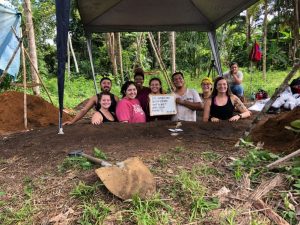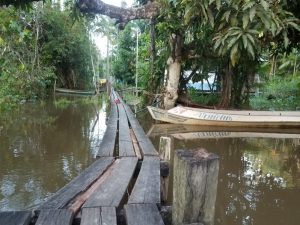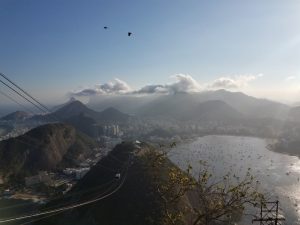September 13, 2018
By: Bill Conger
DeKalb County has its own version of the famous Indiana Jones movie character. 19-year-old Bailey Redmon, a 2017 D.C.H.S. graduate, flew to Gurupa Miri, Brazil this summer for a history-marking archeology expedition.
Along with a team of M.T.S.U. students, the History major dug a 2 meter by 1 meter unit, looking for relics
“We got about 60 centimeters down where it was too deep to reach into, so we had to actually get into it,” Redmon recalls. “One of the girls that I was working with took off her shoes and got in. As soon as she got in, the corner of it collapsed.”
That turned out to be a fortuitous event that revealed an empty ant colony filled with ceramics and vases. It was basically a past generation’s dumping spot that archeologists call trash midden.
“We found shards that were decorated,” Redmon explained. “We think just by the style of the decoration that they were a prehistoric age. We found a couple of pieces of animal bone. Where we dug was an actual mound. There they look for mounds because there’s this soil formation called Terra preta, a type of very dark, fertile anthropogenic soil found in the Amazon Basin. It’s only made by the slash-and-burn agriculture that they do down in South America.”
“There would be like what we call a trash midden in archeology where they dump all their trash. Anything they wanted to discard they would burn it. That’s what we were finding. No human remains. If we found human remains, we more than likely had to have shut down the unit because the people in the community are very sensitive about that. They believe if we mess with any kind of human remains and take them away from where they were buried, then somebody in the community would get sick or they’ll die. It’s just bad luck.”
Getting permission to excavate in the area took years of relationship building in the community.
“We didn’t know if we were going to find anything, but the whole reason they chose to dig there was because archeology had never been performed there,” Redmon said. “Not that they didn’t care about their heritage, but it never really occurred to the people there could be more underneath the surface of where they lived. They were curious.”
“We were making history just by digging there, not necessarily what we were finding, because there never had really been any excavations there but in the past couple of years. I didn’t know that until we got there. We thought it had been a working site for years. “No, it’s only been two years.” So, it was like chill bumps. This is crazy,” she said, laughing.
The Archeology and Medieval Studies minor spent a month in the Portuguese-speaking nation.
“The people treated us like family even though they couldn’t communicate with us. There was this one family. The woman’s name was Doña Arlete We would go down to her house every night after we got done excavating. She would feed us all these sorts of fruits and foods that we hadn’t tried before. She treated us like we were her daughters.”
“She lived right on the Amazon River, so we would swim in the Amazon. The current was really strong, but it was muddy. You couldn’t see. It was a narrow channel so there was a lot of vegetation, jungle vines and trees. There would be huge water lilies that would float down. You would have to dodge them as you were swimming. It was cool.
“I was afraid of the piranhas because that’s where they live, but the Brazillians were jumping in. [I thought] you’re fine. I just jumped in and took a risk. That’s something that I’m glad I did and didn’t hold back and not do it because that’s something I’ll remember for the rest of my life.”
During her two-and-a-half week adventure, she slept in a hammock in a non-air conditioned hut. Although it’s the winter season there in July, cooler than normal temperatures hovered around 85 degrees couple with 100% humidity. As she tried to snooze at night, she met a special friend hanging overhead.
“There was a tarantula that lived there. He was probably about baseball size or so not including his legs. He would come out during the night rain, and he would catch his bugs and not move a muscle. I had a bug net, so I thought worse scenario, he could just fall on me during the night, and I would have to bounce him off of my net.
I ended up having fun with it. I named him Caleb because I thought if I gave him a name, then he wouldn’t seem so intimidating to me. So, every time he would come out, I’d be like, “Hey, Caleb! He’s back’.”
Redmon also got up-close and personal with several other creepy creatures.
“We also had bats that lived with us in the hut. We had huge long centipedes that were around the floor. We had frogs in the shower. All the wildlife you could imagine we had it. Fire ants were terrible.. Underneath some of the boards [on the way to the river], there’d be a colony of ants. So, I got bit several times. I started wearing my work boots with my bathing suit down to the river. I don’t care if I look silly. I’m not getting bit.”
“We had snakes that would fall into our unit [excavation site] at night, and we would have to come and kill them. Usually, they were venomous. There were also hunter spiders that would make their little nests beside our unit. They’re the ones that burrow into the ground and when an insect walks by, they jump out and grab it and bring it back into their hole. We’d have to take a machete and shove it down the hole and tear up the hole to get the spider to come out. Then, either kill it or let it run away.”
Redmon, an M.T.S.U. Senior, hopes to earn her Master’s and PhD at York University in England after she graduates next May. One day she wants to work in historical archeology. Redmon says the obstacles she faced during her trip changed her life.
“I was not prepared for that the first couple of days, but you get used to it. Oh, it’s just a snake or oh, it’s just a tarantula. I’m not skittish around that kind of stuff anymore because of that trip. It just made me grow so much as a person other than that.
“These people … encounter the same things that we did, and they still are some of the happiest people I’ve ever met in my life. They don’t let it get to them. I try to mimic that mentality. There’s nothing you can control, so you might as well be positive about it. If that trip taught me anything, it was a positive outlook is the best thing to have, especially in a tough situation like that.”






